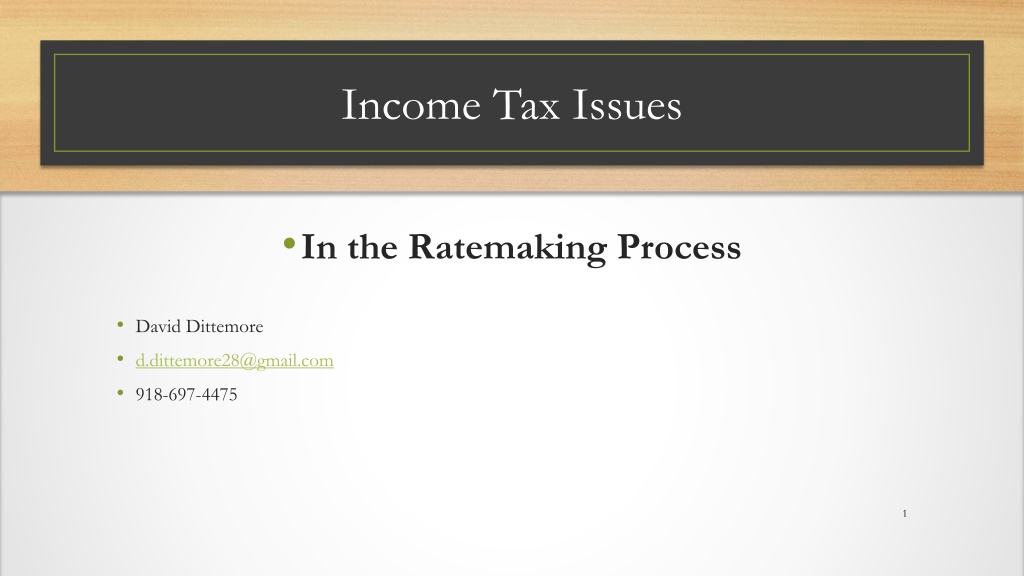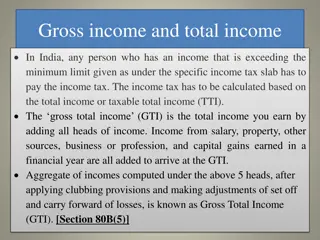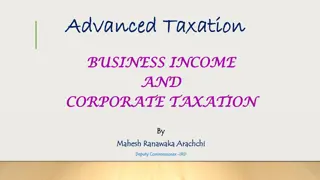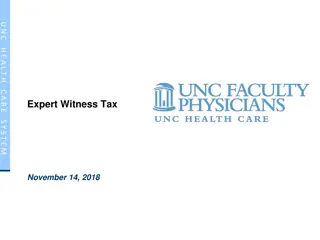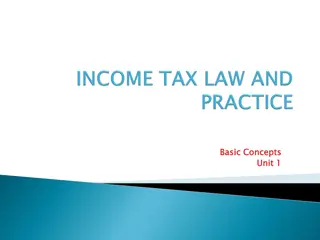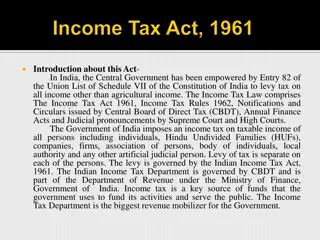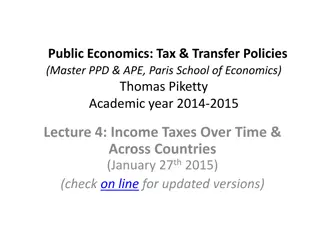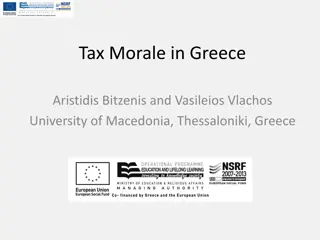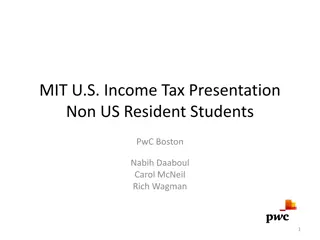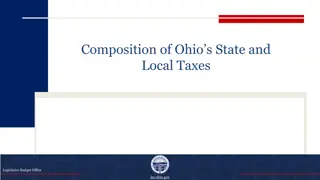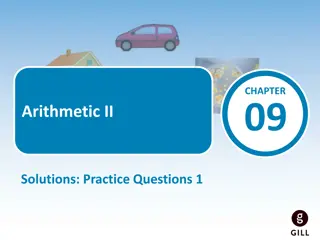Understanding Income Tax Issues in the Ratemaking Process
This content explores various aspects related to income tax issues in the ratemaking process, including Accumulated Deferred Income Taxes (ADIT), Net Operating Losses (NOLs), Tax Normalization, Repair Deductions, and more. It provides insights on how ADIT is calculated, the significance of NOLs, differences between book and tax depreciation, and the impact of Tax Cuts and Jobs Act (TCJA) on Bonus Depreciation and Repair Deductions.
Download Presentation

Please find below an Image/Link to download the presentation.
The content on the website is provided AS IS for your information and personal use only. It may not be sold, licensed, or shared on other websites without obtaining consent from the author. Download presentation by click this link. If you encounter any issues during the download, it is possible that the publisher has removed the file from their server.
E N D
Presentation Transcript
Income Tax Issues In the Ratemaking Process David Dittemore d.dittemore28@gmail.com 918-697-4475 1
Topics Basic Background Information on ADIT. How ADIT is calculated. What to look for in your review of ADIT. Net Operating Losses (NOL s) Definition Recent IRS Developments What to look for in your review of NOL s especially in capital rider filings 2
Normalization is the accounting recognition of GAAP Accounting expenses in the computation of utility income tax expense. Flow-Through is the recognition of tax deductions in the computation of Income Tax Expense. Normalized vs Flow- Through Tax Accounting Normalization accounting is required for book depreciation and the investment tax credit. Normalized and Flow-Through are elements of two sets of books; GAAP and Tax. 3
Tax Normalization (Cont.) Book Depreciation is generally less than Tax Depreciation. Therefore, normalization (book/GAAP depreciation) generally produces higher taxable income and thus higher tax expense. Repair Deduction, and other book/tax differences are not required to be normalized. Most states use the full normalization methodology for determining Income Tax Expense. 4
Repair Deduction The Repair regulations require a detailed analysis of the facts and circumstances of each project. The facts and circumstances are then analyzed in the context of what the regulations refer to as a unity of property. If the expenditure results in the betterment of the unit of property, the restoration of the unit of property, or adapts the unit of property to a new or different use, the amount is capitalized. If it does not, the amount is deducted as a repair. John Wilde VP Tax, American Water Works Service Company. 5
Accumulated Deferred Income Taxes (ADIT) ADIT represents those taxes reflected as an expense on financial books, but not yet paid to fed/state taxing authorities. ADIT = Customer Provided (Cost Free) Capital. 6
Book vs. Tax Depreciation and the Repair Deductions (gas and water utilities) produce the majority of ADIT ADIT (Cont.) The TCJA eliminated Bonus Depreciation. However, the generous Repairs Deduction (especially for gas utilities) remain. The Sum of the Book/Tax timing differences * Tax Rate = ADIT. Tax Rate = composite state and federal. 7
ADIT Detail Sample Data Book Depreciation/Amortization Contributions in Aid (CIAC's) Cost of Removal Tax Depreciation/Amortization SERP Incentive Compensation 22,000,000 $ 1,500,000 (2,500,000) (132,000,000) 250,000 12,500,000 ADIT Sample Calculation Total Multiplied by Composite Tax Rate ADIT Balance (98,250,000) $ 25.94% (25,483,594) $ Tax Rates State: Federal 6.25% 21.00% Calculation of Composite Tax Rate Total Taxable Income Less: State Taxes Equals: Income Subject to Federal Tax Federal Tax Rate Net Federal Tax Rate Plus: State Tax Rate Composite Tax Rate 100% 6.25% 93.75% 21% 19.69% 6.25% 25.94% 8
Request listing of all book/tax timing differences. Request a definition of all book/tax timing differences ADIT Discovery? Are all ADIT items synchronized with the rest of the revenue requirement? Incentive Compensation (book expense > tax) ACA/PGA over/Under recovery Corporate book/tax timing differences Below the line Items (Charitable Contributions for Example) 9
Has the company included ADIT related to corporate operations? ADIT What to Look For? Non-recurring ADIT impacts such as ACA/PGA Over/Under recoveries should be removed. If a forecasted test period is used, has the company reasonably forecasted its ADIT balance? Review Return to Provision (RTP) Entries. 10
Implications of The Selected State Tax Rate Composite State Rate vs. State specific rate Either approach is acceptable, but be wary of inconsistencies. Failing to capture reductions in state tax rates when using the composite state tax rate approach. (monitor other state tax rates). (Limitations posed by retroactive ratemaking) Ensure symmetry between use of State tax rate within the Income Tax Expense and ADIT calculations. 11
Net Operating Loss A Net Operating Loss (NOL) occurs when a utility s Taxable Income is negative; that is when Tax Deductions exceed Taxable Revenue. TCJA modified the use of NOL s Federal Tax Rate Change Legacy NOL s prior to TCJA may continue to offset 100% of subsequent year s taxable income. Prospective NOL s (post TCJA) may only offset 80% of taxable income. NOL s can only be carried forward, cannot be carried back as in the past. No prospective expiration of NOL s under TCJA. 12
Failure to spread the tax benefits of accelerated tax depreciation over the life of the asset. Failure to spread the tax benefits of Investment Tax Credits over the life of the asset. Failure to recognize an NOL Asset in Rate Base reasonably attributed to tax losses generated by accelerated tax depreciation. Failure to synchronize Plant/Depreciation/ADIT/NOL. What is a Normalization Violation? What is a normalization Violation? 13
NOL Rate Base Recognition NOL s (asset) reduce the ADIT Liability and thus increase Rate Base. NOL s must be included in Rate Base to the extent the losses were generated by the requirement to normalize depreciation expense; i.e. depreciation lives and method differences. The major question is how to attribute the net operating losses to the protected accelerated tax depreciation? This question of attribution of an NOL to the requirement to normalize depreciation for tax purposes was one of the issues set out in IRS Notice 2019-33. 14
What is a private letter ruling? A private letter ruling (PLR), or letter ruling (LTR), is a notice the IRS sends taxpayers, typically businesses, that submitted a written request for clarification about unusual tax situations. Taxpayers who have a question about a tax situation unaddressed or not addressed clearly in the tax laws can send a written request to the IRS asking for clarification. 15
Utility Position -With and Without Methodology Method of attributing the portion of (protected) accelerated tax depreciation to the NOL balance. Essentially maximizes the NOL balance required to be recognized in Rate Base. The NOL is attributable to accelerated depreciation to the extent of the lesser of accelerated depreciation or the NOL. I.E. if accelerated depreciation > NOL, 100% of NOL is presumed to be caused by accelerated depreciation; ignoring all other tax deductions. See PLR 148311-13; May 22, 2014 16
EEI/AGA Comments: To the extent a regulated public utility has a depreciation- related net operating loss, the normalization rules require it to include a deferred tax asset in its rate base in an amount equal to the depreciation-related deferred tax liability. (i.e. With and Without methodology) Tennessee Attorney General Comments: The IRS need not identify the precise methodology for assignment of an NOL associated with depreciation. The IRS should avoid making pronouncements concerning the details of rate-making issues which are otherwise within the scope of state utility commissions expertise. IRS NOPR Comments Notice 2019-33 Comments submitted by the following: TN AG VA Corporation Commission KS Corporation Commission WA Utilities and Transportation Commission EEI/AGA; NW Energy, AM Water, Dominion, INGAA, MLPA. 17
IRS Ruling Notice 2019-33 .02 Net operating loss carryforward (NOLC). Compliance with normalization requires a determination of the source of an NOLC so that rate base is not overstated in jurisdictions in which net deferred tax liabilities reduce rate base. While 1.167(l)-1(h)(1)(iii) is the relevant general authority, there is not one single methodology provided for determination of the portion of an NOLC that is attributable to depreciation. 18
IRS Ruling Notice 2019-33 (Cont.) Section 1.167(l)-1(h)(iii) instead informs taxpayers that the amount and time of the deferral of tax attributable to depreciation when there is an NOLC should be taken into account in such appropriate time and manner as is satisfactory to the district director. Regulating commissions have expertise in this area, and any reasonable method for determining the portion of the NOLC attributable to depreciation should generally be respected provided such method does not clearly violate normalization requirements. 19
With/Without vs. Composite Methods Methods for Determing NOL Associated With Accelerated Depreciation % of Year 1 Deductions Taxable Revenue Cash O&M Accelerated Depreciation Repair Deduction Other Deductions Total Deduction $ 600 (250) (300) (100) (50) 35.71% 42.86% 14.29% 7.14% (700) Net Tax Loss Composite Tax Rate (Assumed) NOL Asset $ (100) 26% (26) $ With and Without Method (Acc. Dep. $300 > Tax Loss $100) Composite Method (Acc Depreciation $300 /Total Tax Deductions $700)*NOL ($26) $ (26) $ (11) 20
Notice 2019-33 Implications Determination of NOL s included in Capital Riders Determine the Vintage of the NOL balance when were NOL s generated? Request taxable income calculation for NOL years. Evaluate accelerated tax depreciation vs. all other tax deductions. One approach would be to calculate the ratio of qualifying Capital Rider tax depreciation as a percent of all tax deductions * Tax Losses by year to arrive at protected NOL associated with Capital Riders. The With and Without Methodology, touted by industry, is no longer mandated by the IRS (my opinion re: 2019-33). 21
Potential significant implications on determination of NOL associated with Capital Expenditure Riders. No Longer requires the methodology to maximize NOL associated with accelerated depreciation The With and Without Method is likely currently supported in capital rider calculations by utilities. Item to Consider Compare the sum of the NOL in Base Rates + NOL in Capital Riders to actual NOL per books. Why does Rev Procedure 2020-39 Matter? 22
With and Without vs. Composite re: Capital Rider Methods for Determing NOL Associated With Accelerated Depreciation Capital Rider Scenario % of Year 1 Deductions Taxable Revenue Cash O&M Capital Rider Accelerated Depreciation All Other Accelerated Depreciation Repair Deduction Other Deductions Total Deduction $ 600 (200) (100) (250) (100) (50) 28.57% 14.29% 35.71% 14.29% 7.14% (700) Net Tax Loss Composite Tax Rate (Assumed) NOL Asset $ (100) 26% (26) $ With and Without Method (Acc. Dep. $100 <=Tax Loss $100), therefore $100*26% is attributed to Capital Rider Composite Method (Acc Depreciation $100 /Total Tax Deductions $700)*NOL ($26) $ 26 $ 4 23
Normalization and Tax Equity Financing In the 2020 ruling, the IRS reaffirmed that a new wind generation facility in a tax equity partnership structure would not be considered public utility property under section 168(i)(10) for purposes of determining whether the depreciation deductions from the facility would be subject to normalization rules. This determination was based on the fact that rates for the sale of electricity generated by the facility were expected to be determined on a market basis and not on a rate-of-return basis. 24
